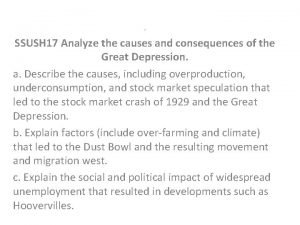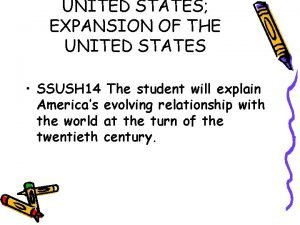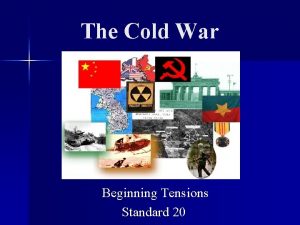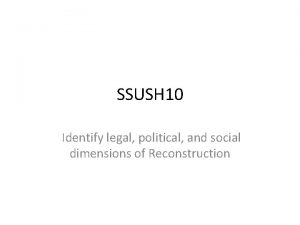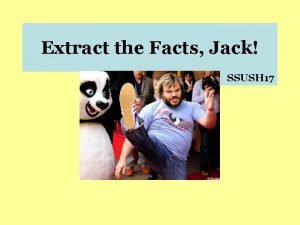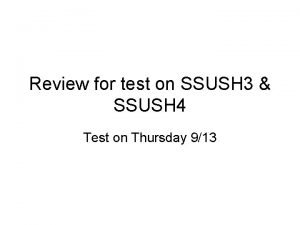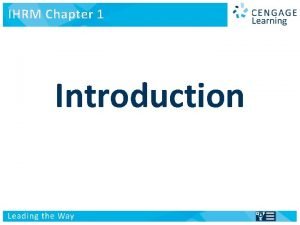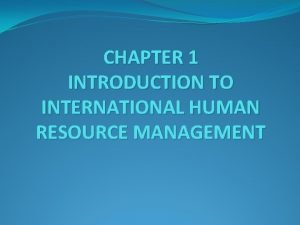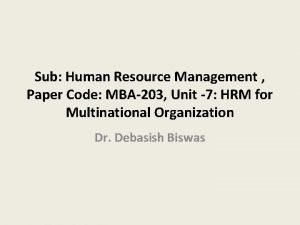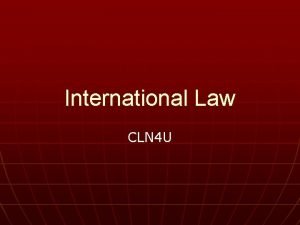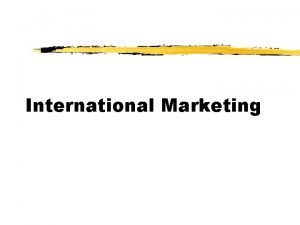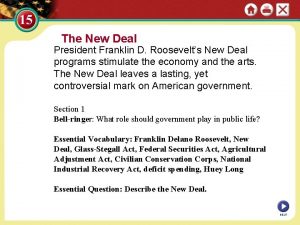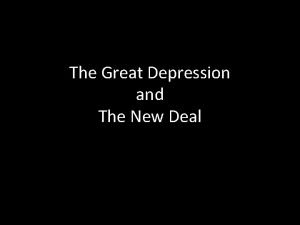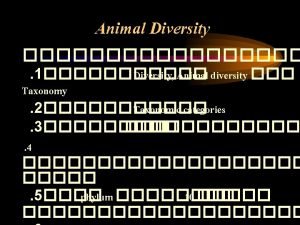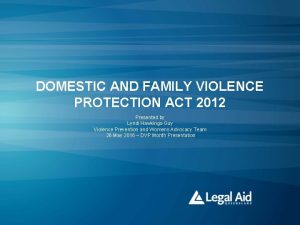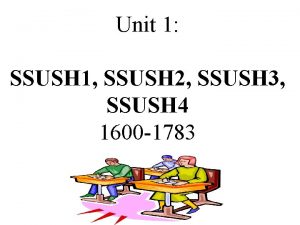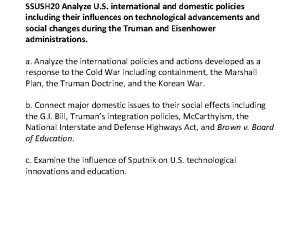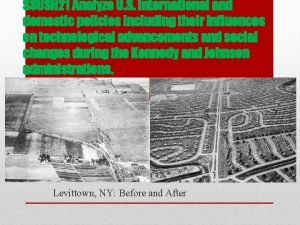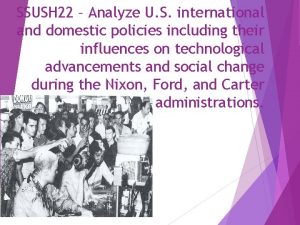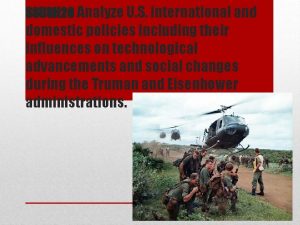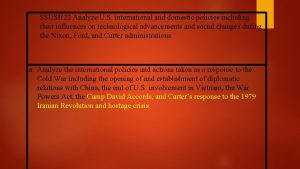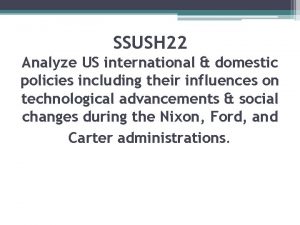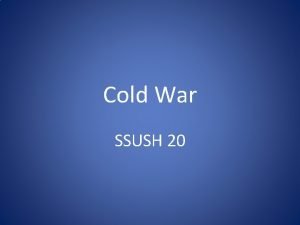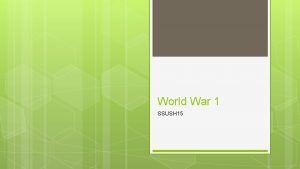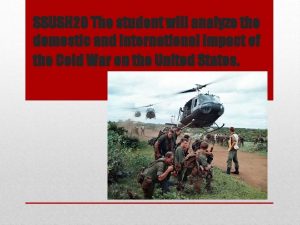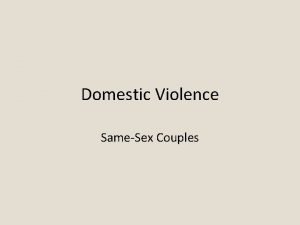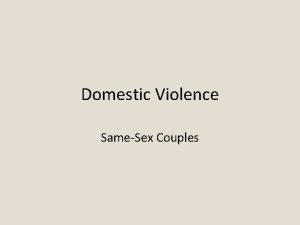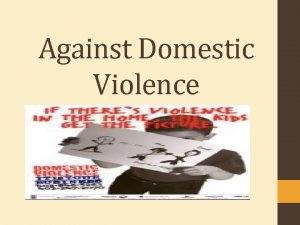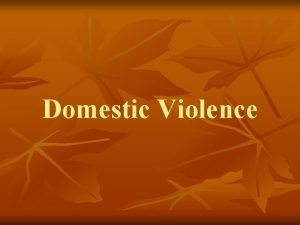SSUSH 21 Analyze U S international and domestic
















- Slides: 16

SSUSH 21 Analyze U. S. international and domestic policies including their influences on technological advancements and social changes during the Kennedy and Johnson administrations a. Analyze the international policies and actions taken as a response to the Cold War including U. S. involvement in Cuba and the escalation of the war in Vietnam as a result of the Gulf of Tonkin Resolution. b. Connect major domestic issues to their social effects including the passage of civil rights legislation and Johnson’s Great Society, following the assassination of John F. Kennedy. c. Describe the impact of television on American culture including the presidential debates (Kennedy/Nixon, 1960), news coverage of the Civil Rights Movement, the moon landing, and the war in Vietnam. d. Investigate the growth, influence, and tactics of civil rights groups, Martin Luther King, Jr. , the Letter from Birmingham Jail, the I Have a Dream Speech, and Cesar Chavez. e. Describe the social and political turmoil of 1968 including the reactions to assassinations of Martin Luther King, Jr. , and Robert F. Kennedy, the Tet Offensive, and the presidential election.

a. Analyze the international policies and actions taken as a response to the Cold War including U. S. involvement in Cuba and the escalation of the war in Vietnam as a result of the Gulf of Tonkin Resolution.

U. S. involvement in Cuba • • In the late 1950 s and early 1960 s the Cold War strategy of containment was put to the ultimate test by events that transpired in Cuba. Only 90 miles from the US, the rise of a Soviet-supported communist regime in Cuba was an obvious problem for the US. The trouble began in 1959, when a revolution led by Fidel Castro successfully overthrew the Cuban government. In 1961, the US trained and led a group of Cuban exiles in an attempt to retake the island. Believing the people of Cuba would welcome the force as liberators, the force landed at the Bay of Pigs, but were quickly and completely defeated. The Bay of Pigs debacle was a major setback for the US. Tensions over Cuba reached fever pitch the following year, when it was discovered that the Soviets were actively establishing a nuclear missile site on the island. What unfolded then was the most intense moment of the Cold War. The US demanded removal of the missiles, but the Soviets refused, and promised retaliation if the US attempted to invade Cuba again. Ultimately the US decided to impose a naval blockade to prevent the Soviets from completing the missile installation. With Soviet ships en route to confront the blockade, armed confrontation seemed imminent, but the Soviets turned their ships around at the very last moment.

Escalation in Vietnam and the Gulf of Tonkin Resolution • Another example of US efforts to contain communism came with the Vietnam War, which raged through the late 1960 s and early 1970 s and result was even less successful than the Korean campaign. • The US first became involved in Vietnam in the 1950 s, as the French colonial regime of Indochina collapsed, leaving the southeast Asian nation vulnerable to a long simmering communist movement led by Ho Chi Minh. • Initially the US offered only economic supports and advisory assistance, but by 1964 Ho Chi Minh’s “Vietcong” forces were gaining strength and the Congress authorized the US to use military force following an event known as the Gulf of Tonkin Incident. The subsequent Gulf of Tonkin Resolution became the basis for a massive escalation of the US military operations in Vietnam in the following years.

• b. Connect major domestic issues to their social effects including the passage of civil rights legislation and Johnson’s Great Society, following the assassination of John F. Kennedy.

Assassination of JFK • John F. Kennedy was elected president in 1960. He was the youngest president ever elected and seemed to embody a new spirit of American progress at the dawn of the new decade. • On November 22, 1963 JFK was killed in Dallas, TX. The shocked and grief-stricken American public looked to his successor, Lyndon Johnson to enact Kennedy’s legislative agenda, which included among other things, major civil rights reform.

Great Society • LBJ’s domestic agenda reflected some very ambitious reforms aimed at addressing racial injustice, systemic poverty, education issues, and access to health care in the US. Collectively, historians refer to LBJ’s agenda and resulting programs (including some that are still around- Head Start, Medicare/Medicaid) the Great Society. The term comes from speeches LBJ gave in 1964.

Civil Rights legislation • Emboldened by what he saw as a mandate to see through JFK’s promise for meaningful civil rights legislation, LBJ applied his unique skills as a politician to make a major push. The resulting legislation largely achieved the primary legislative goals of the Civil Rights Movement: unequivocal and unambiguous laws that ensured equal access to public accommodations (Civil Rights Act of 1964), and unfettered access to the ballot box (Voting Rights Act of 1965).

c. Describe the impact of television on American culture including the presidential debates (Kennedy/Nixon, 1960), news coverage of the Civil Rights Movement, the moon landing, and the war in Vietnam • • • A very important development of the 1950 s and 1960 s was the mass adoption of television. By 1960, 90% of American homes had access to TV. As TV became the number one source of news and information for many Americans, it had a profound affect on politics and public opinion. The rising influence of television on politics was illustrated by the 1960 presidential debates, which featured John F. Kennedy and Richard Nixon. As the story goes, many Americans who watched the debates on TV thought that Kennedy was the stronger candidate, while those listening on radio preferred Nixon. Kennedy looked tan and composed under the TV studio lights, while Nixon looked sweaty and clammy. The election was one of the closest in US history and many historians credit Kennedy’s photogenic and TV appeal as one of the factors that helped him win. Another major impact of TV is its connection to the Civil Rights movement. In the late 1950 s and early 1960 s, television reports and images of the brutal repression of civil rights helped to create a more sympathetic understanding of what African Americans were facing in their struggle for equality. Seeing on a daily basis the arrests, beatings, police dogs and fire-hose attacks on civil rights activists helped to change the minds of many Americans who might have been indifferent prior to seeing these images on TV. TV had a similar impact on public opinion regarding the war in Vietnam. As the war escalated through the 1960 s, the daily exposure to images of brutal fighting and reports of body counts began to change some Americans’ minds about the war. TV also produced some near universally shared cultural moments. A case in point was the broadcast of the moon landing on July 20, 1969.

d. Investigate the growth, influence, and tactics of civil rights groups, Martin Luther King, Jr. , the Letter from Birmingham Jail, the I Have a Dream Speech, and Cesar Chavez. • Dr. Martin Luther King Jr. was arguably the single most important leader of the Civil Rights movement. Born in Atlanta in 1925, he went on to became a minister, and first became well known for his leadership in the Montgomery Bus Boycott of 1955 -6. • Inspired by the philosophy and tactics of Mohandas Gandhi, King advocated for non-violence in the attempts to inspire civil rights reforms in the US. He founded the SCLC (Southern Christian Leadership Conference) in 1957, and had great success in organizing civil rights efforts through black churches. He helped to organize boycotts, marches and rallies, and his impassioned and eloquent oratory helped to change the mindset of many Americans by highlighting the immorality and injustice of racism and segregation. • Two of MLK’s most famous works are his “Letter from a Birmingham Jail” and his “I Have a Dream Speech”

“Letter From a Birmingham Jail” and “I Have a Dream” • • King’s “Letter from a Birmingham Jail” was written in April, 1963, after King was arrested for participating in civil rights protests in Birmingham, Alabama. The immediate context of King’s open letter was as a response to a group of white clergymen, who published an editorial criticizing King as an “outsider” who was unnecessarily stirring up trouble in Birmingham. While acknowledging the injustice facing blacks in Birmingham, they felt King and the civil rights movement should use the political and legal processes to achieve civil rights reform, rather than “take to the streets” and risk social disorder. King’s response was a powerful defense and justification of his non-violent tactics. He argued that the civil rights movement could not wait on the political process, and that “injustice anywhere is a threat to justice everywhere. ” King’s letter was widely reprinted and its major points became a rally cry for civil rights leaders all over the country. Later that same year, King participated in one of the largest public gatherings in US history, the March for Jobs and Freedom, intended to highlight the glaring economic and social inequality facing African Americans and other minorities in the US. Gathered on the National Mall, with the Lincoln Memorial as a backdrop, King delivered an especially powerful message. The central theme was his “dream”, that one day, throughout the Deep South and beyond, Americans would move past racial hatred and that all Americans would enjoy the blessings of liberty and justice promised by our founders. King’s dream was a future where his children, and all men would “not be judged by the color of their skin, but by content of their character. ”

Cesar Chavez • The success of civil rights activism spurred others to advocate for awareness and reforms as well. Cesar Chavez was the leader of a labor organization (United Farm Workers) that represented migrant labor. • Pay and working conditions for many migrant farm laborers was appalling, and Cesar Chavez organized and promoted a successful nation-wide boycott of table grapes and lettuce. Chavez and his union also advocated for immigration reform in the US, and for Civil Rights for Hispanic Americans more broadly.

e. Describe the social and political turmoil of 1968 including the reactions to assassinations of Martin Luther King, Jr. , and Robert F. Kennedy, the Tet Offensive, and the presidential election. • 1968 stands as one of the most turbulent and violent years in US history. Socially and politically the nation seemed to be reaching the boiling point. • In addition to the markedly increased opposition and protests associated with the Vietnam war and the social revolution among the youth, two high-profile assassinations, and an especially turbulent election cycle punctuated the already enflamed tensions in American society and politics.

Vietnam War and the Tet Offensive • 1968 was a major turning point in public opinion regarding the Vietnam War. • Following the Gulf of Tonkin incident in 1964, a massive air campaign ensued, but by 1967 it was clear that substantial ground forces would be needed to quell the Vietcong. At its height in 1968, over half a million US troops were deployed to the sweaty jungles of Vietnam. • Even as American casualties mounted, (nearly 60, 000 American deaths by the end of the war), the Johnson administration was assuring the public that victory was at hand. The so-called Tet Offensive, undertaken by North Vietnamese and communist forces in early 1968, seemed to contradict the administration’s claims of imminent victory. Although the Tet Offensive was largely contained by American forces, the fact that they were able to conduct such an offensive at all helped to further erode public confidence and support of the war.

1968 assassinations • MLK Jr. was assassinated in April 1968 while in Memphis, TN, where he was supporting a strike of garbage workers in the city. His murder sent shock waves across the nation and was followed by days of unrest and riotous violent in many major cities. • Robert F. Kennedy, younger brother to the slain president, was himself gunned down in June, following a victory speech in Los Angeles. He was a Democratic candidate for president and had just won the California primary when a deranged Palestinian named Sirhan shot him. • To many Americans, these assassinations, on top of the increasing anxiety and unrest over civil rights and the Vietnam War, seemed to be indicative of a nation and a society spinning out of control.

1968 election • • • The presidential election of 1968 also reflected the turmoil and social strife of that year. Following the Tet Offensive, deep divisions emerged over the course of the Vietnam War and the tremendous domestic tensions over civil rights and racial inequality. Sensing a political opportunity to challenge LBJ’s leadership of the Democrats, Robert Kennedy (former Attorney General and younger brother of JFK) announced his candidacy for the Democratic nomination in March. Two weeks later, LBJ stunned the world with his announcement that he would not seek reelection. RFK’s assassination in June left the party without a clear front runner and the party was further divided. At the Democratic National Convention in Chicago, party divisions erupted into chaos. The Democrats were hopelessly divided over Vietnam policies, and over 10, 000 protesters, mostly young people, descended on the city to put pressure on delegates to adopt an anti-war platform. The protesters clashed with Chicago police and the National Guard, leading to riots and violence. The unseemly mess was a monumental embarrassment for the Democrats and is often cited as one of the primary reasons why a majority of voters chose the Republican candidate Richard Nixon on election day, who had campaigned on de-escalation in Vietnam and a restoration of “law and order” in the turbulent nation.
 Ssush
Ssush Ssush
Ssush Ssush
Ssush Ssush
Ssush Ssush
Ssush Ssush
Ssush King of england during revolutionary war
King of england during revolutionary war Difference between domestic and international hrm
Difference between domestic and international hrm Introduction to ihrm
Introduction to ihrm Difference between hrm and hrd
Difference between hrm and hrd Transnational multinational global international
Transnational multinational global international International vs domestic
International vs domestic Five international product and promotion strategies
Five international product and promotion strategies Soil conservation and domestic allotment act
Soil conservation and domestic allotment act Soil conservation and domestic allotment act
Soil conservation and domestic allotment act The taxonomy of the domestic dog and humans
The taxonomy of the domestic dog and humans Domestic and family violence protection act 2012
Domestic and family violence protection act 2012
